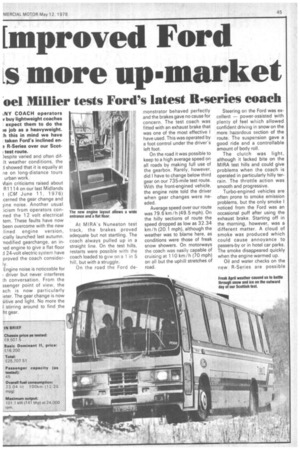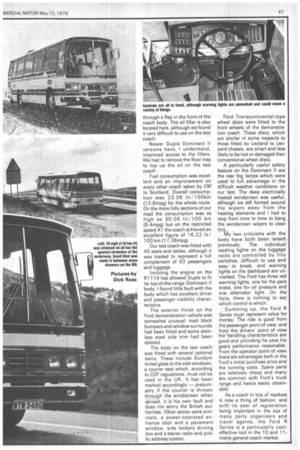Emproved Ford s more up-market
Page 43

Page 45

If you've noticed an error in this article please click here to report it so we can fix it.
oel Milner tests Ford's latest R•series coach
kNY COACH operators v buy lightweight coaches expect them to do the be job as a heavyweight. :h this in mind we have : taken Ford's inclined en R-Series over our Scot' test route.
)espite varied and often difIt weather conditions, the I showed that it is equally at ne on long-distance tours urban work.
Viain criticisms raised about R1114 on our last Midlands
t (CM June 11, 1976) cerned the gear change and One noise. Another usual :icism from operators conned the 12 volt electrical tern. These faults have now been overcome with the new :lined engine version, icially launched last autumn. -nodified gearchange, an inled engine to give a flat floor
J 24-volt electric system have proved the coach considerly.
Engine noise is noticeable for driver but never interferes th conversation. From the ssenger point of view, the ach is now particularly ieter. The gear change is now sitive and light. No more the I stirring around to find the ht gear.
At MIRA's Nuneaton test track, the brakes proved adequate but not startling. The coach always pulled up in a straight line. On the test hills, restarts were possible with the coach loaded to gvw on a 1 in hill, but with a struggle.
On the road the Ford de
monstrator behaved perfectly and the brakes gave no cause for concern. The test coach was fitted with an exhaust brake that was one of the most effective I have used. This was operated by a foot control under the driver's left foot.
On the road it was possible to keep to a high average speed on all roads by making full use of the gearbox. Rarely, however, did I have to change below third gear on our 735-mile test route. With the front-engined vehicle, the engine note told the driver when gear changes were needed.
Average speed over our route was 79.6 km/h (49.5 mph). On the hilly sections of route the speed dropped as low as 32.34 km /h (20.1 mph), although the weather was to blame here, as conditions were those of freak snow showers. On motorways the coach was easily capable of cruising at 110 km /h (70 mph) on all but the uphill stretches of road. Steering on the Ford was excellent --power-assisted with plenty of feel which allowed confident driving in snow on the more hazardous section of the route. The suspension gave a good ride and a controllable amount of body roll.
The clutch was light, although it lacked bite on the MIRA test hills and could give problems when the coach is operated in particularly hilly terrain_ The throttle action was smooth and progressive
Turbo-engined vehicles are often prone to smoke emission problems, but the only smoke I noticed from the Ford was an occasional puff after using the exhaust brake. Starting off in the morning, however, was a different matter. A cloud of smoke was produced which could cause annoyance to passers-by or in hotel car parks. The smoke disap,peared quickly when the engine warmed up.
Oil and water checks on the new R-Series are possible through a flap in the front of the coach body. The oil filler is also located here, although we found it very difficult to use on the test coach.
Newer Duple Dominant II versions have, I understand, improved access to the fillers. We had to remove the floor trap to top up the oil on the test coach.
Fuel consumption was excellent and an improvement on every other coach taken by CM to Scotland. Overall consumption was 23.06 lit/100km (12.6mpg) for the whole route. On the more hilly sections of our road the consumption was as high as 30.05 lit/100 km (9.4mpg) but on the restricted speed Al the coach achieved an excellent figure of 16.22 lit / 100 km (17.36mpg).
Our test coach was fitted with 45 seats and tables, although it was loaded to represent a full complement of 53 passengers and luggage.
Inclining the engine on the R1114 has allowed Duple to fit its top-of-the-range Dominant ll body. I found little fault with the body which has excellent driver and passenger visibility characteristics.
The exterior finish on the Ford demonstration vehicle was somewhat unusual matt black bumpers and window surrounds had been fitted and some stainless steel side trim had been deleted.
The body on the test coach was fitted with several optional items. These include Sundym tinted glass to the side windows, a courier seat which, according to COF regulations, must not be used in the UK. It has been marked accordingly — presumably if the courier is thrown through the windscreen when abroad, it is his own fault and does not worry the British authorities. Other extras were armrests, a power-operated entrance door and a pavement window, side lockers driving box and a stereo radio and public address system.
Ford Transcontinental-type wheel discs were fitted to the front wheels of the demonstration coach. These discs, which are similar in some respects to those fitted by Leyland to Leopard chassis, are smart and less likely to be lost or damaged than conventional wheel discs.
A particularly useful safety feature on the Dominant ll are the rear fog lamps which were used to full advantage in the difficult weather conditions on our test. The deep electrically heated windscreen was useful, although ice still formed around the wipers away from the heating elements and I had to stop from time to time to bang the windscreen wipers to clear this. My two criticisms with the body have both been raised
previously. The individual reading lights on the luggage racks are controlled by tiny switches, difficult to use and easy to break, and warning lights on the dashboard are unmarked. The Ford has three red warning lights, one for the park brake, one for oil pressure and one alternator light. On the facia, there is nothing to say which control is which.
Summing up, the Ford R Series must represent value for money. The ride is good from the passenger point of view, and from the drivers' point of view the handling characteristics are good and providing he uses his gears performance reasonable. From the operator point of view there are advantages both in the Ford's initial purchase price and the running costs. Spare parts are relatively cheap and many are common with Ford's truck range and hence easily obtainable.
As a coach in lots of markets is now a thing of fashion, and with its year of registration being important in the eye of many party organisers and travel agents, the Ford R Series is a particularly costeffective tool in the 10 and 11metre general coach market.












































































































